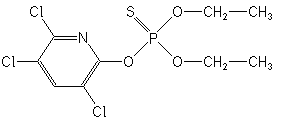
chlorpyrifos
¡¡
Chemical name: O,O-diethyl-O-(3,5,6-trichloro-2-pyridyl)phos-phorothioate
Structural formula:

Molecular formula: C9H11Cl3NO3PS
Molecular weight: 350.5
Physical and chemical properties
Appearance: Technical chlorpyrifos is white
crystalline solid with a mild sulfur odor;
Stability: Wide stability at room temperature;
Density: 1.398(43.5¡ãC);
Melting Point: 41.5~43.5¡ãC;
Vapour Pressure: 2.5mPa(25¡ãC);
Solubility: 1.2mg/l in water, readily soluble in
most organic solvents.
Toxicity
Chlorpyrifos is moderate toxic to animals. Acute oral LD50 for
rats 163mg/kg, acute dermal LD50 for rats>2g/kg; Slight
irritation to eye, serious to skin. Subacute oral non-effect level for
rats 0.03mg/kg, chronic oral non-effect level 0.1mg/kg. Chronic oral
non-effect level for dog 0.03mg/kg. No carcinogenic, mutagenic and
teratogenic effects at experimental dosage. Maximum allowed
concentration0.2mg/m3 (TLV) in indoor air. High toxic to fish
and aquatic organisms, LC50 for bulltrout 15mg/l (96 h, 72¡ãC).
Toxic to bees. Acute oral LD50 of 40.7% chlorpyrifos EC for
rats 590mg/kg, acute dermal for rabbits LD50 2330mg/kg,
irritation to skin and eyes. Acute oral of 14% G for rats LD50>2g/kg,
acute dermal for rats LD50>2g/kg, acute inhale LC50>0.007µg/L(7
h), irritation to eyes and skin.
Also call as: chlorpyrifos, dowco179; ENT27311; dursban, empire, eradex, lorsban, paqeant, piridane, scout, stipend
Quality :
|
Item |
Index
|
|
Content(¡Ý, %)
|
95.0,98.0
|
|
Moisture(¡Ü, %)
|
0.5
|
|
Acidity(H2SO4)(¡Ü, %)
|
0.4
|
Mode of action: Thiophosphate insecticide; Contact, stomach, and respiratory action. Non persistent on leaves, persistent in soil, high efficiency for the control of underground pests. At the recommended dosage, no phytotoxicity for most crop, but sensitive to tobacco.
Specification: ¡Ý95%, 98%
Packing: 45kg plastic bucket or according to clients demands.
¡¡
¡¡
¡¡